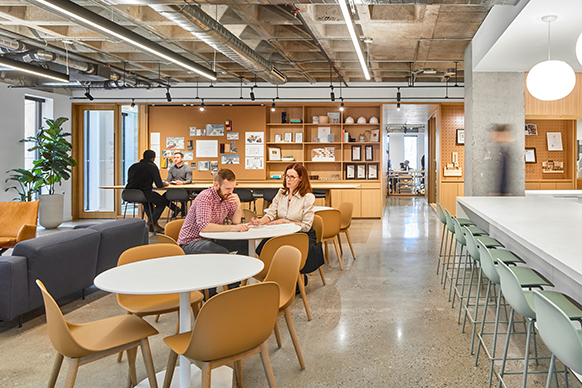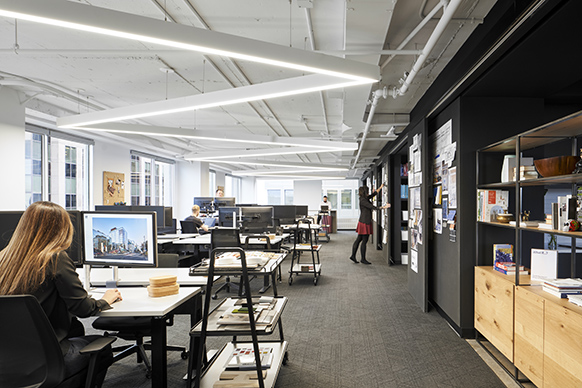“We are in a climate crisis, every decision we make must consider impact on the environment. Embodied carbon is the area of greatest impact for commercial interiors projects, and we are committing to implementing better practices to achieve significant reductions now, and net to zero by 2030,” says Zeina Elali, Senior Sustainability Advisor at Perkins&Will Ontario.
Perkins&Will has a long-standing commitment to environmental stewardship across its 25 studios worldwide. The firm has been publicly reporting reductions in energy intensity through the Architecture 2030 Commitment for over a decade. In 2011, it created the first publicly available material database for healthier, more transparent material selection. It authored the first certification platform for climate adaptation and mitigation, known as RELi, which is now a U.S. Green Building Council program. And in 2020, the firm launched a new work paradigm called Living Design, which seamlessly blends sustainability, resilience, well-being, regeneration, and social equity into every project.
“We know carbon emissions have negative impacts on our planet, and to-date most of the focus has been on operational carbon. We are bringing focus to embodied carbon in corporate interiors because as designers and architects we can do something about it. Ultimately, we are looking to bridge the gap between our clients corporate sustainability and net zero goals and their real estate and design strategies,” says Janine Grossmann, Principal and Corporate Interior Practice Leader.
Embodied carbon is the total amount of carbon dioxide emissions that a material, system, or assembly represents over its life cycle. It is an aggregate of all emissions released during ingredient extraction, product manufacturing, transportation, and end-of-life reuse or non-use. Statistics suggest embodied carbon is responsible for 11% of all global greenhouse gas emissions annually. In the building sector alone, it accounts for more than a quarter of emissions, with the design and construction of interior spaces acting as a major contributor.
The problem is compounded by interior renovations and new tenant fit-outs. Old interior building materials frequently get discarded rather than reused, and with large leases turning over every 10 years, maybe less, the emissions impact increases over time.
As noted above, our commitment aims to address the gap between an organizations’ corporate sustainability aspirations with net-zero promises and their real estate strategy. Many organizations have set targets over the next 10 years to reduce the built environment’s impact on the climate, we want to lead the charge to assist with achieving those goals.
Why is this important?
Embodied carbon is the area of greatest impact when it comes to interiors.
- Short lease terms and churn of interior fit-outs account for 25% of embodied carbon of a building’s lifetime carbon emissions.
- Globally, embodied carbon of buildings accounts for 11% of emissions annually.
- Interior materials require massive energy in their harvesting and manufacturing.
- Large amounts of construction waste in landfill, decomposing over years.
How Can We Design to Reduce Embodied Carbon?
- Extending lease terms. Short lease terms and churn of interior fit-outs. Extending leases extends material service life.
- Reduce quantity of materials and/or materials that require massive energy during manufacturing.
- Extensive analysis of finishes to compare typology and manufacturer.
- Design to reduce waste. Large amounts of construction waste end up in landfill, decomposing over years.
- Design for end of life focusing on the circular economy. Select materials that are reusable, recyclable, or sent back to manufacturer once retired.
Many Partnerships.
Clear Milestones.
One Goal.
To ensure all commercial interior design work is net-zero embodied carbon by 2030, the Toronto and Ottawa studios of Perkins&Will set a series of milestones targets to achieve:
- By 2025, our design teams will reduce embodied carbon of our commercial interiors portfolio by 50%.
- Starting immediately on all new interiors projects, design teams will prioritize materials that have low or zero embodied carbon. This will be done alongside durability, health impact, and aesthetics.
- Design teams will make it a priority to learn about end-of-life use of materials—recycling, reuse, buy-back, reconfiguration, and biodegradation.
- Design teams will research and specify at least one interior product or system that can help reduce the project’s overall embodied carbon.
- Starting immediately, we will help accelerate knowledge and actively engage in discussions with clients, corporate real estate portfolio managers, constructors, product manufacturers, consultants, and industry associations to discuss adjustments to the supply chain that reduce their embodied carbon and promote a circular economy.
- We commit to promoting free sharing of knowledge and share our research and findings. We acknowledge this climate crisis will take a collective effort to defeat.
- In cases where design alone cannot ensure net-zero embodied carbon, design teams will work with clients to choose carbon offsets.
- By end of 2021, we will issue our first annual progress report, not only for accountability, but also to share our lessons learned and identify gaps in the industry that we can collectively seal.
Our commitment to designing net-zero embodied carbon interior spaces is one of the latest examples of Perkins&Will’s global leadership in sustainability. Recently, the firm’s London studio and Washington, D.C. studio have pledged to meet a similar goal for clients. The firm’s Vancouver and Calgary studios also committed to providing clients in Western Canada with carbon assessments for projects to reduce both operational carbon and embodied carbon.
“We look forward to teaming up with the industry to achieve our Net Zero Embodied Carbon interiors commitment,” says Elali, “Clients, consultants, contractors, and manufacturers will all form a critical part of making this initiative successful. As we set this ambitious benchmark, we believe this initiative will be possible in Ontario and beyond, and we look forward to leading the way.”
Follow the conversation on social media using the hashtag #netzeronow.



